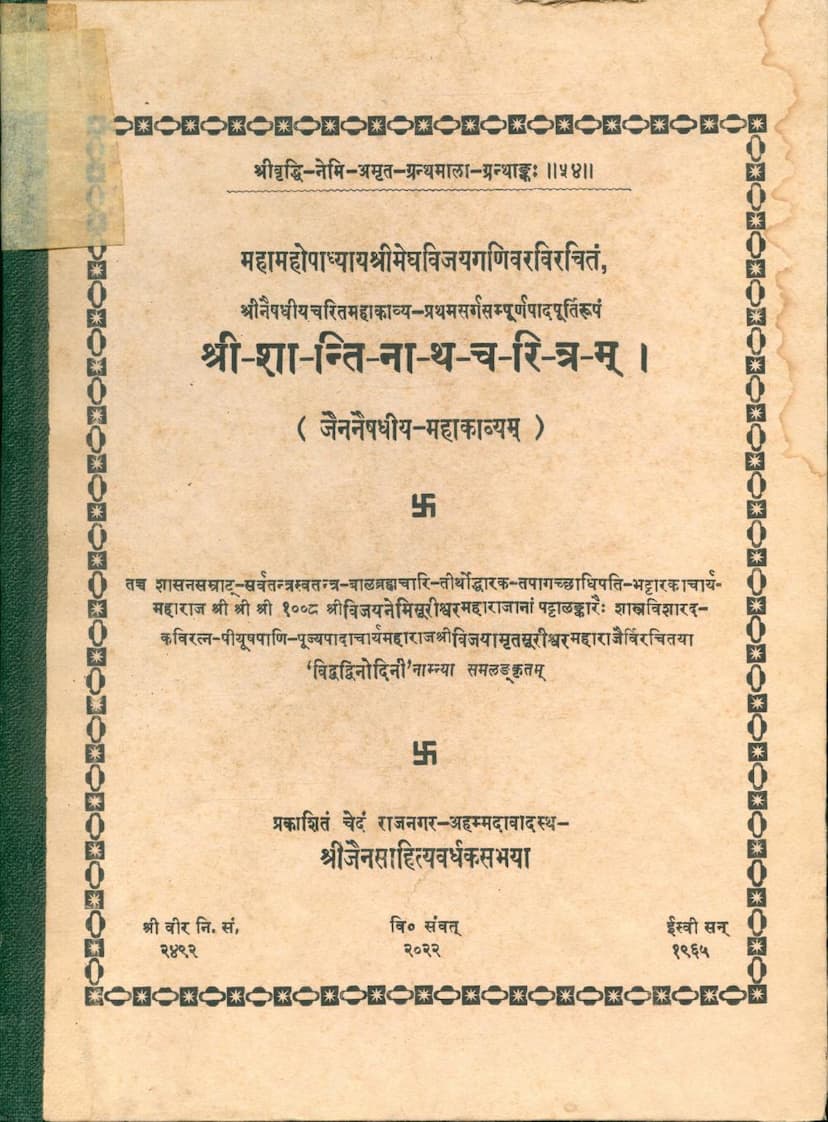Shantinath Charitram
Added to library: September 2, 2025

Summary
Here is a comprehensive summary of the Jain text "Shantinath Charitram," based on the provided text:
Title: Shantinath Charitram (also referred to as Jain Naishadhiya Mahakavyam)
Author(s): Amrutsuri, Abhaydevsuri (as indicated by the publisher's note, though the primary text described is by Meghvijay Ganivar)
Publisher: Shri Jain Sahitya Vardhak Sabha, Rajnagar-Ahmedabad
Publication Year: Vir Samvat 2492 / Vikram Samvat 2022 / 1965 CE
Catalog Link: https://jainqq.org/explore/004339/1
Overall Nature of the Text:
The text is identified as a Jain Mahakavya (epic poem) detailing the life and deeds of Lord Shantinath, the 16th Tirthankara of the current time cycle. It is presented as a "Padapürti" (completion or filling in the missing verses) of the first canto of the renowned Sanskrit epic "Naishadhiya Charita" by Harshavardhana. The text is notable for being a Jain adaptation or commentary on a classical Hindu epic, aligning the life of a Tirthankara with the grandeur and poetic style of a well-known non-Jain work.
Key Features and Content:
-
Authorship and Commentary:
- The original work is attributed to Mahamahopadhyay Shri Meghvijay Ganivar.
- It is adorned with a commentary named "Vidyadvodini" (or "Vidvadvinodini" as written in the text), authored by Poojyapada Acharya Maharaj Shri Vijayamrutsurishwarji Maharaj. He is described as a scholar, a gem of poets, and a disciple of the great Acharya Shri Vijaynemisurishwarji Maharaj, who was a pillar of the Jain faith.
- The commentary is praised for its clarity, depth of meaning, and its ability to maintain the poetic rasa (aesthetic delight) of the original while explaining complex concepts. It focuses on the meaning of the verses and avoids excessive grammatical discussions, making it accessible to those who appreciate poetry.
-
Purpose and Style:
- The primary aim of the Shantinath Charitram is to provide a "Padapürti" (verse completion) for the first canto of the Naishadhiya Charita. This means that the author took each verse of the first canto of Naishadhiya Charita and created a Jain interpretation, filling in the verses to align with the Tirthankara's life story.
- The author, Meghvijay Ganivar, is acknowledged for his mastery in Padapürti (a poetic technique of completing existing verses), having previously undertaken similar extensive works for works like Meghdoot and Naishadhiya.
- The text is described as being rich in Shabdalankaras (sound-based figures of speech) due to its poetic nature, but also incorporating Arthalankaras (figures of speech based on meaning) consistent with the grandeur of the Naishadhiya Charita.
- The text is considered challenging to comprehend and requires a good understanding of poetry and Sanskrit vocabulary, appealing to scholars and poetry enthusiasts.
-
The Life of Lord Shantinath:
- The introduction highlights the special significance of Lord Shantinath among the 24 Tirthankaras of this aeon. His life is particularly attractive, and his attribute of "Shanti" (peace) is emphasized, making his presence essential in rituals, hymns, and meditations.
- The Charitram is divided into six cantos (Sargas).
- Canto 1: Describes Hastinapur city, King Vishwasen, Queen Achira, the birth of Lord Shantinath, and his beauty.
- Cantos 2 & 3: Detail Lord Shantinath's marriage, the appearance of celestial gems (like the Chakra), his journey for the conquest of six continents, the gait of his horses, and descriptions of dust rising from the marching army. It also includes seasonal descriptions.
- Canto 4: Covers the coronation as Chakravarti (universal monarch), the state of his kingdom, and his renunciation leading to his departure to the forest.
- Canto 5: Narrates his initiation, austerity, attainment of Kevala Jnana (omniscience), establishment of the Tirth (Jain order), and his sermons.
- Canto 6: Depicts his Nirvana (liberation), the grief of his disciples (Ganadharas), its alleviation, and the management of the Shasan (Jain teaching).
-
Literary and Scholarly Context:
- The introduction also provides brief overviews of other works describing the life of Lord Shantinath by various prominent Jain scholars like Devachandrasuri, Hemchandracharya, Manichandrasuri, and Munidevasuri.
- It corrects a potential confusion in the attribution of a work by H. Jacobi regarding the author's name, clarifying it as Muni Devsuri and not Devasuri.
- The text emphasizes its contribution to Jain literature and its potential to aid in spiritual development and liberation.
Significance:
- Jain Adaptation of Classical Epics: This work is a significant example of how Jain scholars integrated classical Indian literature with Jain philosophy, enriching the Jain literary tradition.
- Poetic Excellence: The commentary highlights the high caliber of poetry and scholarship involved, making the life story of a Tirthankara accessible to those with a refined taste for literature.
- Spiritual Guidance: The text is intended not only for literary appreciation but also for spiritual upliftment, offering teachings and inspiration for the path of liberation.
In essence, Shantinath Charitram by Meghvijay Ganivar, with the commentary Vidyadvodini by Vijayamrutsurishwarji, is a scholarly and poetically rich Jain epic that reinterprets a classical Sanskrit epic to narrate the life of Lord Shantinath, offering profound spiritual and literary insights.